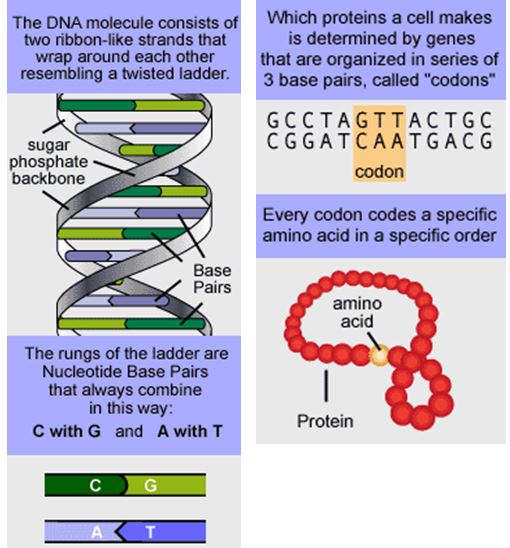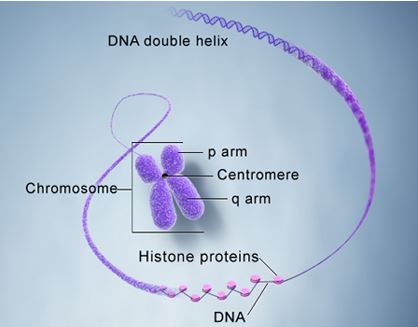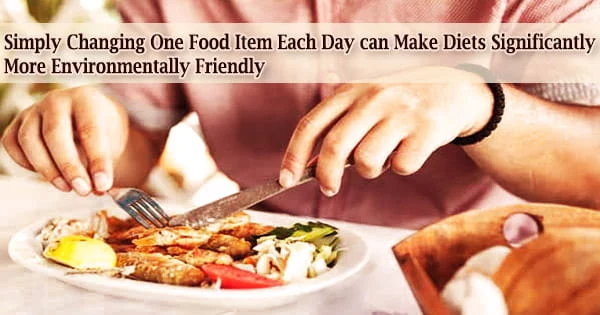To a large degree in Genetics and Heredity , it’s a function of the genes. A gene is a portion of DNA that determines characteristics. Through meiosis and reproduction these genes can be transmitted from one generation to another. Genes are the basic units of heredity they have in common.
How does this happen?
Our body is made up of trillions of cells. In some ways, these cells can be very different from each other. For example, they can specialize in a particular function, such as carrying oxygen (red blood cells), absorbing food (intestinal cells), or sensing light (cells in your eyes).
In other ways, these cells have a lot in common. For instance, at the center of almost all of your cells is a ball-shaped structure called the nucleus, inside of which are 46 thread-like structures called chromosomes. These chromosomes contain the estimated 35,000 genes that, in many ways, make us who we are.
To understand how we end up with a given set of genes, we need to learn more about chromosomes.
Chromosomes
A chromosome is a long strand of DNA, packaged together with proteins and other kinds of molecules.

Humans have two types of chromosomes: sex chromosomes and autosomes. Two sex chromosomes determine the sex of an individual, and they are called the X chromosome and the Y chromosome.
If you are female, you have two Xs, and if you are male, you have one X and one Y (although there are genetic conditions in which this varies). The autosomes comprise the other 22 chromosomes.
Each cell nucleus contains two copies of each autosome (44 chromosomes), plus two sex chromosomes (either two Xs or an X and a Y) for a total of 46. With few exceptions, the chromosomes and genes found within any two cells of your body will be identical.
The mystery as to why you resemble your family members is solved by discovering how you inherited your chromosomes from your parents.
Cell Division
Each chromosome within our body (except sex chromosomes ) is created by making a copy of a previously existing chromosome. This occurs during the process called mitosis, during which cells divide for growth or repair. Before each division, the cell makes an identical copy of each chromosome and during mitosis, each of the two new cells receives a complete set of 46 chromosomes.

A slightly different process called meiosis takes place during the production of egg and sperm cells When they unite at fertilization to form the nucleus of a human zygote. If the sperm and egg carried 46 chromosomes, like the rest of the body’s cells, then the zygote would have 92, which would be incompatible with life.
You resemble your parents
You resemble your parents because half of the instructions — genes — for making you came from your father and half from your mother. Similarly, your brother or sister also received half of their genetic instructions from each parent, but the set they received is somewhat different from the set you received. That’s why they may resemble you, but they are not identical to you. Identical twins receive exactly the same combination of genes and chromosomes.
DNA
How do cells know what to do in your body? How can DNA determine what you will look like?
Instructions that provide almost all of the information necessary for a living organism to grow and function are in the nucleus of every cell. These instructions tell the cell what role it will play in your body. The instructions are in the form of a molecule called deoxyribonucleic acid, or DNA.
DNA is the chemical responsible for preserving, copying and transmitting information within cells and from generation to generation.
In humans, the DNA molecule consists of two ribbon-like strands that wrap around each other, resembling a twisted ladder. This is often described as a double helix. DNA is contained in tightly coiled packets called chromosomes, found in the nucleus of every cell. Chromosomes consist of the double helix of DNA wrapped around proteins. The DNA molecule contains genes that direct the production of proteins.
Proteins are molecules that play a critical role in the structure, function, and regulation of your body’s cells, tissues, and organs. Every protein is made up of a chain of building blocks called amino acids. The code that is carried by DNA determines which amino acids will come together in what order to form a given protein. Genes act, or “express,” themselves by dictating the order of amino acids used to make proteins.
The twisted ladder is made up of repeating units called nucleotides, each of which is a single building block of DNA. Nucleotides are composed of one sugar-phosphate molecule (the linear strands or outer rails of the ladder) and one base. DNA consists of two nucleotide strands joined by weak chemical bonds between the two bases, forming base pairs. A base pair is a rung or step on the ladder of the DNA. The bases are called A (for adenine), C (for cytosine), T (for thymine) and G for guanine.


These bases always pair up in the following way:
· A+T
· C+G
A single strand of DNA is made of letters:
ATGCTCGAATAAATGTGAATTTGA
The letters make words:
ATG CTC GAA TAA ATG TGA ATT TGA
The words make sentences:
<ATG CTC GAA TAA> <ATG TGA ATT TGA>
These “sentences” are called genes. Genes tell the cell to make other molecules called proteins.

We have approximately three billion base pairs (6 billion bases total) of DNA in most of our cells. This complete set of genes is called a genome. With the exception of identical twins, the sequence of the bases is different for everyone, which makes each of us unique.
Heredity
DNA provides the set of coded instructions required by every organism for specifying its traits. The DNA molecule also provides for a reliable way for parents to pass their genetic code from one generation to the next. Heredity refers to this passage of these instructions from one generation to another.
Location of DNA

Gene-Chromosome Model
Hereditary information is contained in genes, which are composed of DNA, located in the chromosomes of each cell. Chromosomes are found in the nucleus of each cell.

Each gene carries a separate piece of information. An inherited trait of an individual can be determined by one gene, but is usually determined by the interaction of many different genes.
A single gene can influence more than one trait (characteristics). A human cell contains many thousands of different genes coding for many different traits. Changes in the sequence of the DNA molecule and therefore the gene are called mutations. A mutation may change the manner in which a trait is expressed by an organism.
















